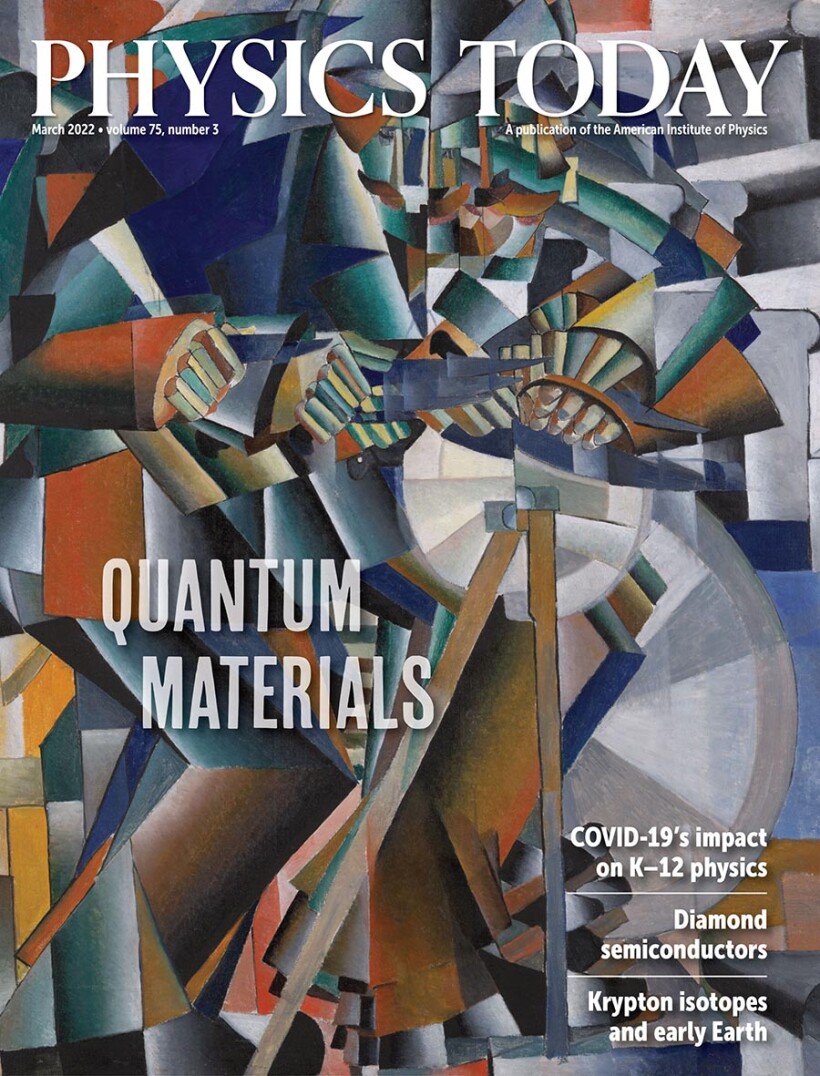Behind the Cover: March 2022

Each month, Physics Today editors explore the research and design choices that inspired the latest cover of the magazine.
Two feature articles about quantum materials appear in Physics Today‘s March issue. In one, Peter Lodahl, Arne Ludwig, and Richard Warburton describe how advances in quantum materials are leading to new applications in quantum computation. In the other, Tim Langen describes dipolar supersolids, a class of quantum materials that are simultaneously solid and superfluid.
Physics Today‘s graphic designer, Freddie Pagani, was responsible for the March cover. Given the issue’s special focus on quantum materials, she and I sought a cover image that either depicted a quantum phenomenon or at least evoked one. Alamy and other purveyors of stock photography have computer-generated images that aim to suggest the quantum world. But the images tend to look generic. Worse, they don’t look especially quantum to me.
A core quantum concept is the superposition of states. A quantum object can simultaneously occupy several states until it is interrogated. In the early years of the 20th century, when quantum mechanics was in its infancy, artists represented different positions of moving objects or different viewpoints of the same objects by depicting those “states” in the same painting. Perhaps the most notable example of that approach is Marcel Duchamp’s Nude Descending a Staircase (No. 2) of 1912. But the painting’s fame put me off. I want Physics Today‘s readers to be surprised when they see a cover for the first time.

Nude Descending a Staircase (No. 2), by Marcel Duchamp, oil on canvas (1912), Philadelphia Museum of Art. (Image from Coldcreation/Wikimedia Commons/public domain.)
Pagani and I looked for alternatives. I found a different Duchamp, Nude (Study), Sad Young Man on a Train of 1911–12. We deemed it too gloomy, both in subject and in its palette of different shades of brown. Pagani struck a rich seam of potential covers in the work of the futurist Giacomo Balla. His Bambina x balcone (Girl Running on a Balcony) of 1912 seemed particularly apt for the March cover. Not only does it superpose various states of motion, but it’s also composed of colored dots that are suggestive of the atoms in a supersolid. Unfortunately, securing the right to reproduce the painting took too long.
Despite that disappointment, the idea of pursuing a futurist painting for the cover remained in play. The image that Pagani; Physics Today‘s art director, Donna Padian; and I chose for the cover is Tochil’schik Printsip Mel’kaniia, or The Knifegrinder, painted by Kazimir Malevich, who was born to an ethnic Polish family near Kyiv in 1878. Like Nude Descending a Staircase (No. 2) and Bambina x balcone, the 1912–13 painting evokes quantum superposition. Its blocky composition evokes solid materials.
One of the characteristics of Malevich’s artwork is his combination of strong colors. To avoid any clashing, Pagani chose white for the Physics Today logotype and pale gray for the cover line.
The cover line is in a sans serif typeface called Cheap Pine. Pagani chose it because its slightly rough edges complement the not-quite-straight edges of the structures in Malevich’s painting. Cheap Pine was designed by Hannes von Döhren, who founded the Berlin-based HvD Fonts in 2008. The typeface’s name comes from the typeface’s inspiration: The font is a tribute to the wood type of the 18th and 19th centuries.
Charles Day is the editor-in-chief of Physics Today.